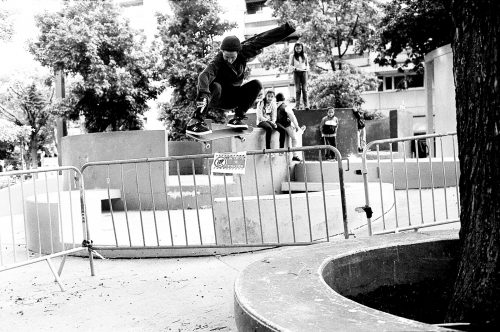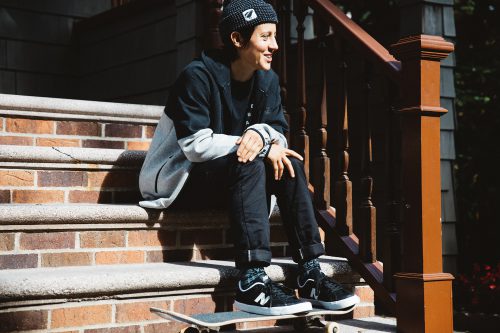Intro & Interview by Zach Baker
Headline Photo by Richard Hart
PJ Ladd’s Wonderful Horrible Life was an anomaly. For the kids who had their own local crews, it was strange and inspiring for this shop out of Melrose, Massachusetts to release this incredible skate video of people we’d never heard of, and reach as large of a viewership as it did. P.J’s part was obviously the main draw, and while there were many standouts — including Jereme Rogers at a time when his only musical connection was Buena Vista Social Club, Ryan Gallant’s east coast tech, the mean guy in the paper boy hat, and don’t get me started on Fiske — a particularly eye-opening moment of the video was when we were introduced to Alexis Sablone. Her part, in some pathetic way, enlightened a generation of young male skaters to the notion that females in skating existed outside of the only woman we had ever really been shown: Elissa Steamer.
I had seen Jaime Reyes and Elissa’s skating at that point, but something about the fact that there was this girl who completely ripped in a random homie video, reinforced the idea that there’s a grander female presence throughout skateboarding. It drew attention to women’s extreme lack of visibility in skating.
In the time since, Alexis is still ripping and placing in most of the contests she regularly enters — but what’s dope is that she also, like, fully went to Columbia, and has a Masters in Architecture from MIT. What’s even more wild, and a perfect example of the resourcefulness of people who happen to skateboard, is that she completely financed her education with contest earnings. I don’t care what you did down D7, this way of juicing of the system is the most impressive skate trick I’ve ever seen.
You’re from Connecticut?
Yeah. I’m from a town called Old Saybrook. It’s a small town not that far from Groton, kind of the bottom middle of Connecticut.
Was there much of a skate scene there when you were growing up?
Not at all, or if there was, I wasn’t aware of it. I started skating when I was ten. I started at a new school that year that was a few towns over. I was in fifth grade and there were a bunch of eighth grade boys who skated, so that was my first contact with other skateboarders. It’s funny because, I had a skateboard, and I was still struggling with it for a while, trying to figure it out on my own. I was playing tag or something and jumped off this twelve foot jetty and broke my foot. When I started at that school, I had DC Clockers and was on crutches. All the boys were like “Whoa, you skate?” I was like “Oh yeah. Yeah, yeah, I skate.” But on the inside I was panicking like, “Oh man, I have to get good at skating!” As soon as I got my cast off, I was in the garage like “I’ve gotta figure out how to ollie.” They were cool, but mostly I just skated alone in my garage. There was this one skatepark an hour away, and I finally started going there. I’d make my mom drive me, or I’d take the train on weekends. I met Trevor Thompson, who’s still like my best friend. We started skating together every weekend.
When did you start going to Boston?
Boston didn’t happen until I was like fifteen. I met a bunch of Boston dudes — Jereme, Eli, Zered and Louis Sarowsky — at Woodward one summer. I became friends with them. Then, I went to Boston once with my family for a weekend, met up with Jereme and we skated all day. He introduced me to Matt and Arty, the Coliseum guys, and that’s when I met PJ. I started going there every weekend or staying there for the summer.
And that’s how you ended up accumulating a full part’s worth of footage?
Yeah, I don’t know if I’d call it a full part. I think I filmed most of it in a couple days, it was just random. It didn’t even feel like I was filming a part, oddly enough. Actually, most of it’s filmed at MIT. Then, we went on a road trip. We took this van down to Miami and stopped in Philly and Atlanta, so some of it is from that too.
You seem to be one of the smarter people skateboarding, having a Masters degree in architecture and all.
Yeah, I guess everything comes and goes in waves. You oscillate between wanting one thing or another; one kind of structure versus another kind of structure. I think that’s why I’m always all over the place. I get really fixated or obsessed, but those obsessions change. I always have two things. Usually one is a project or school — something I’m learning or trying to make. Skateboarding is my release from that stuff; it’s the only time my brain shuts off. Then, sometimes skateboarding is my project.
Are there any parallels between your interest in architecture and your interest in skateboarding?
Both are spatial and creative. You’re trying to make something, and there’s a mental choreography involved. You’re imagining moving through a space in a new way. First, it’s mentally, then you either try to retroactively construct that space, or in skating you’re like “Okay, I thought of it, now I’m go to try to do it.”
I think that there’s a certain obsessive nature. Skaters and architects are the nerdiest people — they’re obsessed with specifics. All of skateboarding is so specific. The difference between one trick and another can be something that people either don’t look at twice or freak out over, and it’s identical to 99.9% of the population. I think architects too — you’re paying attention to these small things because it’s the difference between something that’s satisfying and nice, aesthetically or spatially, and something that doesn’t work, is extra or something about it rubs you the wrong way. I feel both those things. I think there’s some similarity between the way architects and skateboarders see space and think about it.
So skateboarding didn’t consciously lead you down that path toward pursuing architecture?
No, I think that other people will try to impose that. They’ll see a building I designed, and they’re like “Ohh, you’re trying to make it skateable!” When I’m drawing something or trying to figure out a space, I’m not like “Yeah…I’m gonna skate on this.” And wouldn’t that be a skatepark in the end? That’s the fun: the counterculture, whatever skateboarding was formed out of. It’s finding things that weren’t meant for you and being like, “I’m gonna do something new with this.” So if you’re there designing a building with a secret quarterpipe in it, it’s like, I guess that’s sick, but it would be way sicker if that happened by chance.
Photo via New Balance
Is that your job right now?
Am I an architect? No. I’ve been working on this book for a while, a graphic novel that’s related to architecture. I’m still working on that, it has been this never-ending. I mean, it is a big project so I’ll cut myself some slack.
Are you writing and illustrating it?
Yeah. Hopefully, that will be finished in the next few months or year maybe. I’m about to start working for a large-scale sculpture artist who hires architects. She’s a 70-year-old woman who is interested in robot arms and flying saucers and outer space. I’ll be working for her a couple days a week.
Are you signed up for the contest circuit this year?
The circuit (laughs.) There’s not like one piece of paper where you sign up for them all. Yeah, I’m gonna do “the circuit” again. X-Games, Street League and hopefully some contests in Europe. I did that last summer. I mean, I got hurt there so that sucked, but it’s really fun because the contests are smaller and not as stressful. You get to travel to a bunch of cities. I’ll do those.
What do you think about the discrepancy in cash purses between women and men?
It’s hard to advocate for yourself and your own group of people. We deserve as much as these guys. But you see the guys at Street League and they don’t mess up. You don’t see anyone messing up on a skateboard and it’s weird. That’s not even human. So part of you is like, “Oh, I guess that’s why they’re gonna make so much money.” But then, actually, that’s fucked up. The discrepancy is embarrassing. It’s like, what, a tenth? It’s like 30 grand to 250 grand or something? It’s a huge difference. On one hand, you’re grateful to have the opportunity to make even that amount of money in one day and to be invited to these things. I don’t want to shit on that, it allows me to live my life a certain way because I have that opportunity. But it’s also kind of like, what is that saying? Are girls worth less to you? I don’t know how it works, I don’t know about sponsors, I don’t know about any of that, but it’s like, just change it.
Have you noticed any positive advancements for women in skateboarding?
Yeah, definitely. I think a lot of that has to do with the Olympics. People don’t want to invest unless there’s potential to make a lot of money in the future. Yes, there are more contests now and I think girls are starting to make some money. For a long time, no one was getting paid by sponsors. It’s frustrating because as a skateboarder and as an adult, there are things you need. You need to live somewhere and you need health insurance. You’re jumping down and over stuff for a living. How is someone supposed to dedicate all their time and energy to something when their basic needs aren’t being met? So I think it’s changing and hopefully that positive momentum will continue.
The gap in skill will start to shrink as more girls start skating. It’s numbers: if there are hundreds of thousands of guys who skate, there’s going to be a bigger group that are insanely good. There just aren’t as many girls. Skateboarding’s not football, you know? I mean yeah, if you brought a girl and a guy to one massive set of stairs, in terms of physics and if the guy weighs more and is stronger, it’ll be easy for him to get over those stairs. But I think any other arguments about female anatomy are bullshit. We’re not gladiators. It’s about creativity and style.
I know that it’s a stupid question from someone who’s not an architect, but what’s your favorite building?
I’m pretty sure the rest of the world hates this and only architects like it, but I really like brutalist architecture. Like heavy horizontal slabs of concrete. It was big in the late sixties. In the late sixties, there was also this thing called metabolism. The metabolists were a group of Japanese architects that started coming up with super structures, ways to deal with the quick urbanization in Tokyo. They’re crazy looking. There were a lot of projects going on at the same time that were mostly drawings and collages. Super Studio is this Italian group of architects that did all these collages. There was this project called Continuous Monument, which was an endless, sleek, glass, monumental-scale thing passing through the whole world.
There’s some brutalist stuff in New Haven, Connecticut. Paul Rudolph was the dean of the Yale School of Architecture for a while in the sixties, and he designed their building. It’s very brutalist, really thick, rough concrete on the outside. The students hated it so much they tried to burn it down. There’s also this great parking garage in New Haven. When I say that architects are nerds, my MIT class took a trip to New Haven and we spent the majority of our time in a Paul Rudolph parking garage. It’s this parking garage that’s really famous, but only amongst architects. Everyone else is like “Ew, that thing?” “Yeah, it’s amazing!”
Are you still hurt?
A little, I can push around. I had surgery eight weeks ago. I hurt myself seven months ago and skated all those contests hurt. I think April is when I start ollieing.








Interesting people make interesting skaters. She is both
interesting individual. really liked reading this. reason that men make more than women in skateboarding is simple though: the skateboard industry makes most of its money from selling product to (the parents of) 10-15yr old boys who aspire to be like nyjah huston, not nora vascocellos. alexis is correct in that it is all about the numbers. the more young girls that get into skating, the more shit you can sell oriented towards them which would lead to increased revenue towards woman pros. skate industry 101
Great interview.
V cool
thank you
I know it might sound strange, cause i’ve never met her (due to her living on the other side of the planet) but I’ve been a big fan of her since PJsWHL. And finally here she is…Thanks Jenkem!
I wish you all the best and I still kinda love you Alexis :)
b.
Respect
awesome interview. haha all that comes to mind when i think about brutalist architecture is woodhull hospital. shouts out to pat smith and jake johnson and whoever else
thanks jenkem!
http://newhavenmodern.org/temple-street-parking-garage
http://prudolph.lib.umassd.edu/node/4591
hey ty jankem